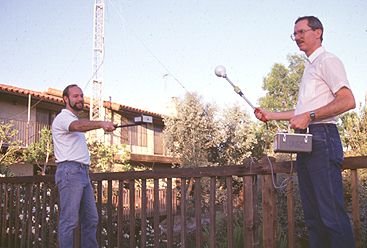|
A new issue has arisen in recent years in amateur radio: concern about RF safety--and about new FCC regulations intended to address that concern. No one would deny that radio frequency energy can pose health hazards. It has been known since World War II that RF energy has thermal effects (i.e., it can cause body heating) if the power density is high enough. The thermal effects of RF energy can include blindness and sterility, among other health problems. But in the last two decades, new research has suggested that under certain circumstances even low level RF energy may have athermal biological effects. Some of this research has generated media publicity, causing public concern that has not always been based on the facts. I first worked on this issue when I served on the legal staff of the National Association of Broadcasters in the early 1980s. The FCC was then considering Docket 79-144, which proposed to require FCC licensees to meet RF safety standards for the first time. From the broadcast industry's viewpoint, this had pros and cons. On one hand, complying with federal standards might be costly for some broadcasters--and some questioned whether there was enough scientific evidence to justify having FCC-mandated standards. But on the other hand, the potential for much stricter local standards (standards that were not necessarily based on good science) prompted broadcasters to conclude that having uniform, scientifically based national standards was best. Clearly, this issue could not be ignored. By the early 1980s, several localities had adopted completely unrealistic RF exposure standards.  When Docket 79-144 was adopted, amateur radio operators were given a categorical
exemption from the routine evaluations of RF exposure around their stations
that were required of other licensees. Amateurs were not exempt from
complying with the standards; they were merely exempt from finding out
if they complied with the standards. In 1990 the FCC and the
Environmental Protection Agency conducted measurements of the RF fields
at a number of amateur radio stations in Southern California. The photo
at left shows the EPA's Ed Mantiply (left) and the FCC's Dr. Robert Cleveland
conducting measurements on the deck of an amateur's home near Los Angeles.
Their conclusion was that most amateur radio activities produced only very
weak RF fields in inhabited areas, although they did note higher power
densities near certain installations, especially a vehicle-mounted station
that was using relatively high power.
When Docket 79-144 was adopted, amateur radio operators were given a categorical
exemption from the routine evaluations of RF exposure around their stations
that were required of other licensees. Amateurs were not exempt from
complying with the standards; they were merely exempt from finding out
if they complied with the standards. In 1990 the FCC and the
Environmental Protection Agency conducted measurements of the RF fields
at a number of amateur radio stations in Southern California. The photo
at left shows the EPA's Ed Mantiply (left) and the FCC's Dr. Robert Cleveland
conducting measurements on the deck of an amateur's home near Los Angeles.
Their conclusion was that most amateur radio activities produced only very
weak RF fields in inhabited areas, although they did note higher power
densities near certain installations, especially a vehicle-mounted station
that was using relatively high power.
By the early 1990s, there was still more research pointing to possible health effects of RF energy at athermal levels. Professional bodies were adopting stricter standards for RF exposure, and in 1992 the American National Standards Institute (ANSI) revised its own guidelines to recommend much greater protection from RF exposure for the general public. The FCC responded with Docket 93-62, proposing to adopt most of the new ANSI standard for its licensees. When the new rules were adopted in 1996, amateurs were no longer exempt from doing routine evaluations of the RF fields around their stations. However, the required evaluation can be done with a simple computer program or even by consulting a chart. And it turned out that virtually all amateur stations could comply with these new requirements without major changes in their antennas or station configurations. This page has several links. One is a follow-up article on the effect of the new rules that I wrote in 1998 for the Proceedings of the Central States VHF Conference. Another is a BASIC computer program that I published in CQ VHF magazine in January, 1997. This public domain BASIC program was reviewed for accuracy by the staff of the Office of Engineering and Technology at the FCC; it can be used with confidence to do routine evaluations. Suggestion: when you download it, save it as an ASCII text file (not as an HTML file). With some browsers it is necessary not only to select "plain text" as the type of file but also to have ".txt" in the name to get a clean copy. Once it's on your hard drive, rename it as "RFSAFETY.BAS" so it will run as a BASIC program. It will then run under any version of GWBASIC, BASICA or QBASIC. The startup command is similar to this: C:\>GWBASIC RFSAFETY, assuming GWBASIC.EXE and RFSAFETY.BAS are both on the root directory of drive C:\. In addition, both the FCC and the ARRL have a great deal of material available online concerning RF safety issues. The FCC's site includes the official Bulletin 65, Supplement B, which specifically addresses amateur radio RF safety compliance issues and includes charts and tables that may be used in routine evaluations. The ARRL has an extensive discussion of RF safety, with links to many other resources--including an article that I published in QST in 1994 to summarize research on this issue. .
-Wayne Overbeck, N6NB
|